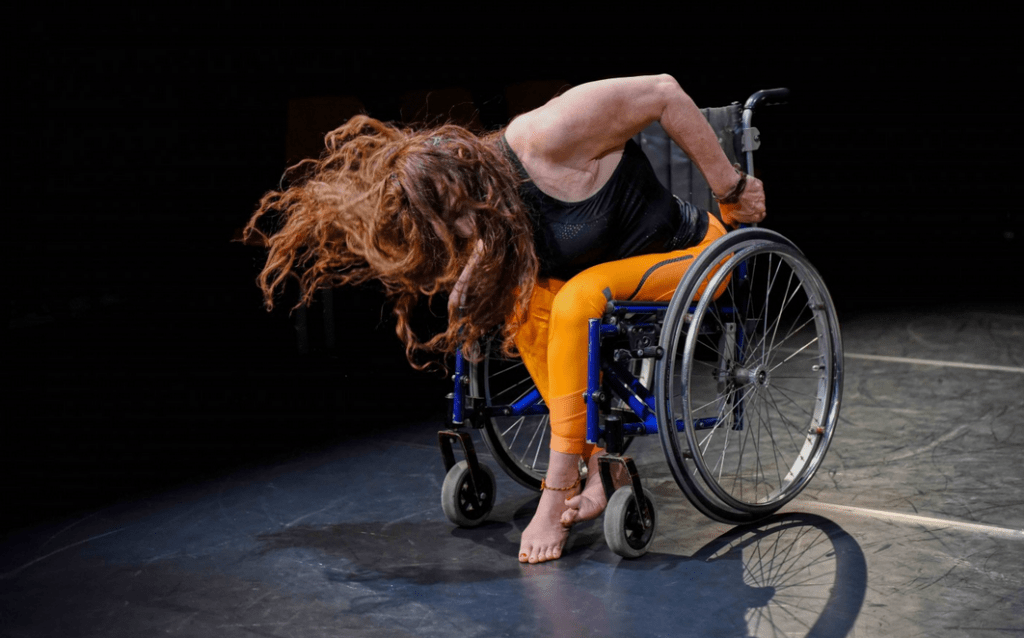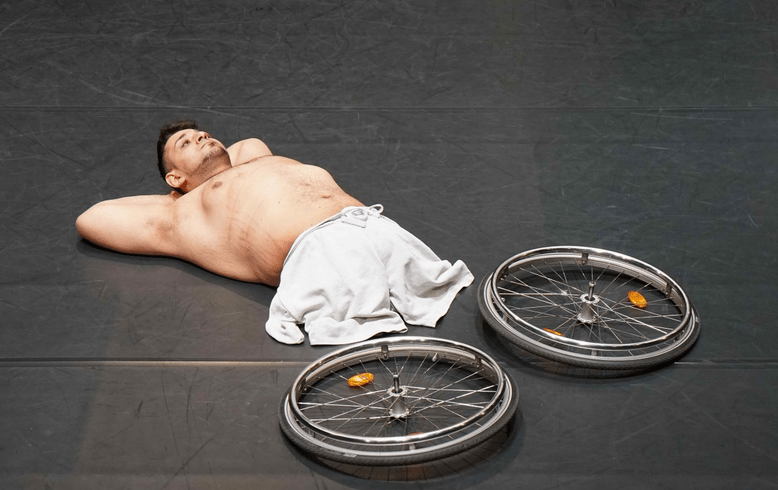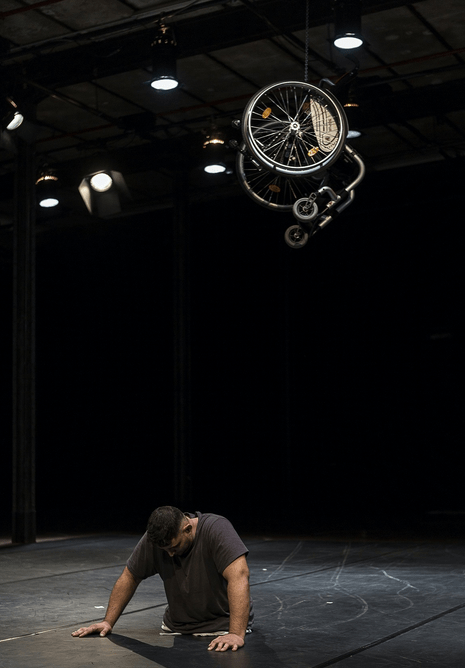The joy of moving your body
By Miranda Laurence
My whole body is shaking, vibrating slightly in a rhythm – a strong, regular pulse. The music plays an infectious techno beat. On the stage are two performers inhabiting that beat, moving and pulsing in inescapable repetition. I am shaking, or rather being shaken, because the seating rack shakes from the movements of my fellow audience members, pulsing their own bodies. We can hear and see the beat. The performers, Adil Embaby and Vera Rosner-Nógel, face us and watch us with delight, almost glee in their eyes, pulsing with small movements of their torso, head, limbs. It is encompassing, it draws me in deliciously, I feel myself sliding into the power of the pulse across all my senses.
I am watching Every Body Electric, choreographed by Doris Uhlich and presented at Bora Bora in collaboration with De Frie Felts festival. In this hour-long piece, two performers, dressed in everyday clothes, inhabit the thrust stage. Taking a stationary place on stage, they move their bodies in small, pulsing motions emanating from a specific body part: chest, hips, legs, and so on.
The movement responds to the strong and dominating beats of an electronic music score, which shifts rhythm, mood and pace through the performance. Occasional moments in which one of the performers’ wheelchair is detached from their body form the only scenographic element. In this performance, any idea of narrative, character or even conceptual ‘meaning’ is overshadowed by simple, stark statements about the joy of moving your body. This is the central mood I reflect on in my review.

The pleasure and infectiousness of pulse
In the seminar Unapologetic Bodies on Stage held before the performance, Uhlich shared, with not a little mischievous glee, her desire to shake her body: in particular, to revel in the fatness of her body as it shakes. For this purpose, she created a ‘shaking table’ to electrically increase the sensations of shaking. After a performance with the shaking table, she had a conversation with someone who uses an electric wheelchair, who had recognised the parallels between what Uhlich had been exploring and their own experience of living with technology. This was the moment that Every Body Electric was born.
Uhlich explores getting energy from movement (rather than putting energy into movement) – a bit like an alternative to taking in caffeine. The pleasurable sense of finding movement that generates energy is literally palpable in Every Body Electric. It is one of several aspects of the piece which set it apart from any other dance performance I have witnessed and that lead me to rethink my assumptions about the experience of spectating dance.
The performance made me reflect on how unusual it is to expect people to move their bodies when they watch dance. Whereas it is completely normal for people to move in response to seeing and hearing live music, dance audiences are often seated and still. By contrast, I observed most audience members of Every Body Electric pulsing, in one way or another. Because of the physical infrastructure of the theatre that pulsing movement transferred itself through the seating rake even to those who weren’t moving by themselves. It is likely that this movement was in response to the accompanying music, which for most of the performance was a heavy, measured techno beat. But I think that we were also moving in response to seeing others move – that is, seeing the performers perform their pulsing for us.
Building a bond between performers and audiences
The music was DJ’d live during the show by Boris Kopening. In a post-show talk, Uhlich and the creative team explained that the DJ changes and selects music in response to what he gleans, live, from the movements of the performers. In this sense, even the beats that we were hearing, and which our bodies responded to, originally emanated from the movements of the performers, guided by the energy of their bodies in that particular moment. As a result, there is a quite extraordinary dynamic between the performers’ movements and the audience’s movements.
The direct gaze of the performers was another unusual experience for me in a long history of watching contemporary dance. In Every Body Electric, the two performers take their places at spots around the thrust stage, close to and facing the audience, looking into individual audience members’ eyes. They pulse and shake right there, exuding their pleasure at pulsing and shaking. At other times, they take their places lying down or facing each other.
Staring at bodies – often sparsely dressed – as they contort themselves, is a behaviour which I have been acculturated to understand as impolite, unless it’s in the specific context and within the specific discourse of stage performance. Even more so, when the bodies I am looking at are naked; even more so, when the bodies I am looking at are naked and disabled, as was the case in Every Body Electric. However, the performers’ confident gazes and pleasurable pulses made me feel at ease with watching them.

Putting nakedness on stage
The performers don’t start naked; the relationship with the audience is built up through the direct gaze, and the joint experience of feeling and moving to a beat. By the time the clothes start coming off, I am therefore much more attuned to looking at the performers as people rather than as mere bodies which may or may not be sexualised. This testifies to Uhlich’s attitude to nakedness in public, which she also talked about in the seminar. She is interested in the power of showing naked bodies in public and particularly in the power of collective nakedness, to enable us (particular as spectators) to divorce nudity from sexualisation.
It is not an easy feat to put naked bodies on stage, and my experience as a spectator is often to wonder why; to feel bored by the shock that I am perhaps supposed to be feeling; uncomfortable at watching someone trying to generate some sort of emotional response in me that I am not having. In Uhlich’s performance, this experience is different. I do not feel that I am supposed to have a shocked reaction – neither to the nakedness itself nor to the nakedness of the bodies that do not conform to stereotypical norms. I see the performers showing us their pleasure in moving, their enjoyment of the energy of repeated, pulsing movements. And in watching this, I feel pleasure too.
In watching footage from Uhlich’s other work (for example Habitat/Halle E), I am struck that her project in exploring the power of collective nakedness is not to generate a particular affective response in the viewer. Rather, it seems to be about the possibility of showing individuals dwelling in pleasurable movement. But of course, Every Body Electric, which offers the audience a time and space to witness disabled bodies moving in pleasure, cannot not be political.
Dancing with disability
Uhlich is at pains to explain (in the seminar and in the post-show talk) that the performers of Every Body Electric have been leading the process: firstly, in inviting her to give a workshop about her practice of shaking; secondly, in their decision to create a public performance piece arising from the workshop; and thirdly, in their decision to use nakedness as part of the piece. In Every Body Electric, Uhlich is the facilitator of a situation in which non-normative bodies perform in front of a spectatorial gaze figured around the mutual experience of pleasurable rhythm.
The political nature of that is evidently clear to Uhlich, though she may – despite her role as choreographer – not be its primary force. Because of the unusually strong bond between the performers and the spectators and the clear sense that the performers are the driving creative force, the performance challenged my assumptions about ‘disability dance’. My experiences of encountering and working within the British disability arts sector in the early to mid 2010s gave me the sense that the ownership or the force of a political statement – which is unavoidable when there are people with disabled bodies performing for spectators – had to lie with a choreographer or the creative originator of an idea. But Every Body Electric proves that it is not necessarily so.

The performers perform both with their wheelchairs and also move around beyond their wheelchairs. At one point, a wheelchair is carefully hoisted up from the flies, and remains dangling over the head of the performer as he lies on the ground pulsing. This act pits the strange smoothness of the gently rotating chair against the pulsing and rhythmic quality of the performers’ movements. The interaction between the chairs and the performers figures the chairs not as props or scenography, but proposes them almost as cyborgian extensions.
The intertwining of mechanical and technical elements – the chairs and the techno music – with the human bodies enriches the overall kinaesthetic experience. The chairs are not just present as an additional element of the body which enables movement; and they are not just present as necessary but unrelated contraptions which accompany the performers’ everyday life.
Every Body Electric: potent inclusivity
In experiencing Every Body Electric and hearing Uhlich talk about her projects, I am struck by her dedication to exploring an idea that is very personal to her artistic project, and her simultaneous willingness to share that idea with others without tightly controlling the forms that the performance of her idea take on stage. It is evident that Uhlich’s delight remains in facilitating an idea to grow. Ultimately, this results in a potent inclusivity, in which the project of exploring what happens when we let our bodies move pleasurably to enjoy movement, spills from Uhlich to the performers, and right through to us. I am left with the impression that we all made the work what it is, as we all responded to the beats, and let our bodies shake.
Every Body Electric spillede på Bora Bora d. 28. januar 2023 som en del af Det Frie Felts Festival
Læs mere her
Koreografi: Doris Uhlich
Dramaturgi: Elisabeth Schack
Performere: Adil Embaby, Thomas Richter og Vera Rosner-Nógel
Lys, rum: Gerald Pappenberger
DJ: Boris Kopeinig
Kostume: Zarah Brandl
Feedback: Yoshie Maruoka, Theresa Rauter
Produktion: Margot Wehinger
International Distribution: Something Great
Miranda Laurence is a dance dramaturg and cultural producer, currently PhD Researcher in the ‘Mobilizing Dramaturgy’ programme at Centre for Dance Research, Coventry University and Department of Dramaturgy and Musicology, Aarhus University. Her work often focuses on generating and facilitating surprising meetings between academic researchers, artist practitioners, and lay experts, including as founder-director of Oxford-based academic and practice exchange programme ‘Dance & Academia: Moving the Boundaries’ and as Arts Development Officer at the University of Reading. She has published reviews and reflective pieces for The Theatre Times, Oxford Dance Writers, and The Learned Pig
